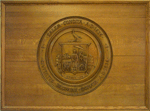Count Rumford: Difference between revisions
No edit summary |
No edit summary |
||
| Line 2: | Line 2: | ||
he left (abruptly) with the British in 1776. | he left (abruptly) with the British in 1776. | ||
Rumford's father died at age 26 when Benjamin was only 2 years old. At 13, his guardian Joshua Simonds apprenticed Benjamin to Appleton in Salem. | |||
Lindall-Gibbs-Osgood house in the book, ''Architecture in Salem''. It has been known as the "Rumford House" and the "Red Cross" house. The American Red Cross | |||
Rumford was apprenticed to John Appleton who traded in salt fish. He lived with Appleton in the Georgian Colonial house (built in 1755) at 314 Essex St. Known as the | |||
Lindall-Gibbs-Osgood house in the book, ''Architecture in Salem''. It has alternately been known as the "Rumford House" and the "Red Cross" house. The American Red Cross | |||
bought it in 1947 and used it until the mid 1990's when it was changed over to offices. | bought it in 1947 and used it until the mid 1990's when it was changed over to offices. | ||
While in Salem he attended the village school. He was extremely bright and excelled in mathematics, astronomy, an making mechanical devices. | |||
He spent much of his life as an employee of the Bavarian government where he received his title, "Count of the Holy Roman Empire." | He spent much of his life as an employee of the Bavarian government where he received his title, "Count of the Holy Roman Empire." | ||
Revision as of 11:17, 20 April 2012
Count Rumford,(1753-1814) for whom the Rumford fireplace is named, was born Benjamin Thompson in Woburn, Massachusetts in 1753 and, because he was a loyalist, he left (abruptly) with the British in 1776.
Rumford's father died at age 26 when Benjamin was only 2 years old. At 13, his guardian Joshua Simonds apprenticed Benjamin to Appleton in Salem.
Rumford was apprenticed to John Appleton who traded in salt fish. He lived with Appleton in the Georgian Colonial house (built in 1755) at 314 Essex St. Known as the Lindall-Gibbs-Osgood house in the book, Architecture in Salem. It has alternately been known as the "Rumford House" and the "Red Cross" house. The American Red Cross bought it in 1947 and used it until the mid 1990's when it was changed over to offices.
While in Salem he attended the village school. He was extremely bright and excelled in mathematics, astronomy, an making mechanical devices.
He spent much of his life as an employee of the Bavarian government where he received his title, "Count of the Holy Roman Empire." He is primarily known for the work he did on the nature of heat. Back in England, Rumford applied his knowledge of heat to improve the heat coming from fireplaces. He made them smaller and shallower with widely angled covings so they radiated heat better. It became known as the Rumford Fireplace.
See Also
- Card from the "Snag File" at the Ref. Desk
- Architecture in Salem Lindall-Gibbs-Osgood House, by B. Tolles, p. 180
